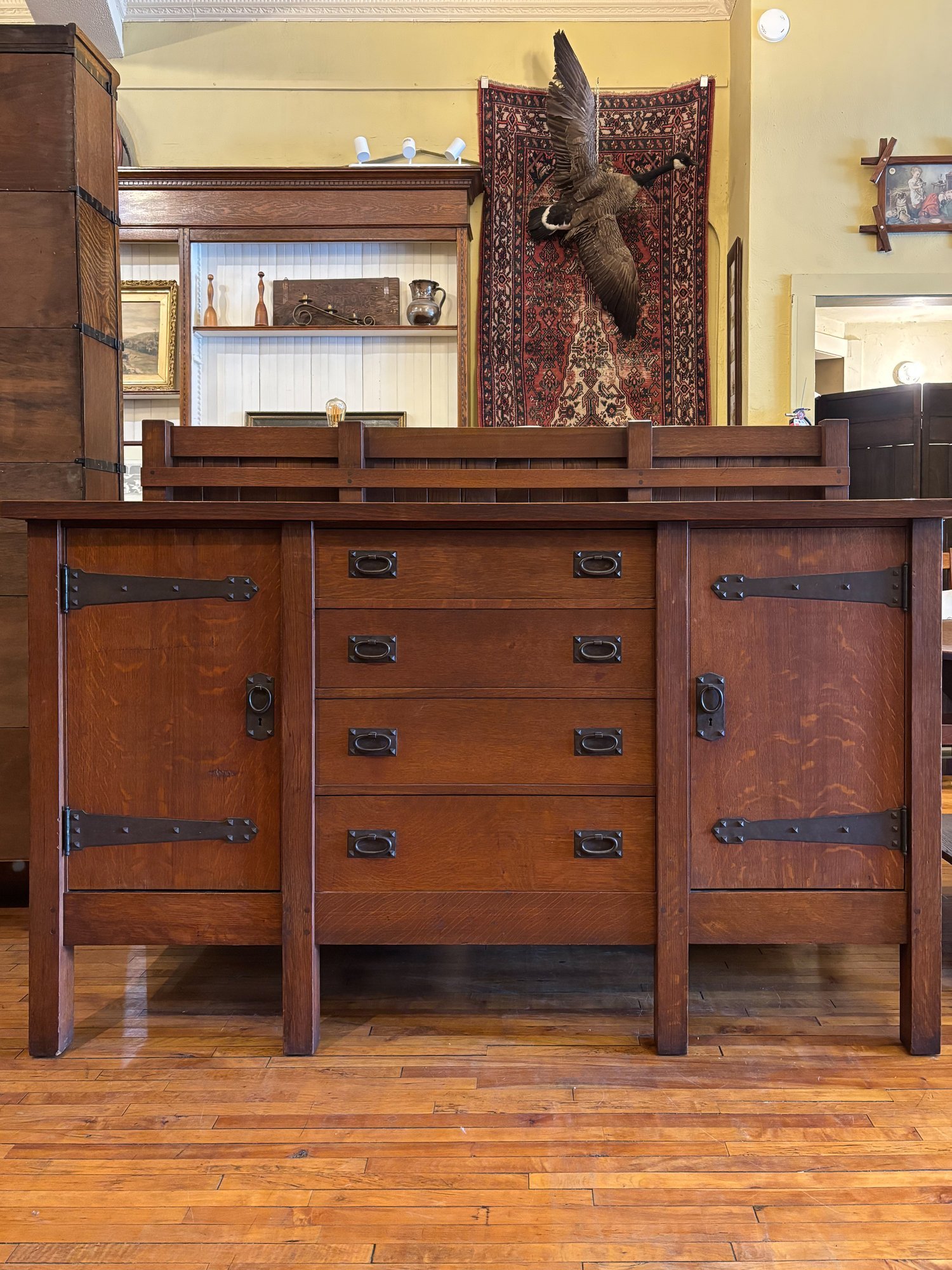Speak the Language of Craft: A Beginner’s Guide to Arts & Crafts Furniture Terms
If you’ve ever stepped into a store like ours and heard words like quarter-sawn, mortise and tenon, or old-growth oak, you’re not alone. The world of antique Mission and Arts and Crafts furniture is full of specialized language — and every word tells a story of how (and why) these pieces were built to last.
This guide will help decode and give examples some of the most common terms you’ll hear in the world of early 20th-century craftsmanship — the vocabulary of a quiet rebellion against mass production.
1. Quarter-Sawn Oak
Quarter-sawn oak refers to the way the log is cut at the mill. Instead of being sliced flat (like modern furniture), the log is cut into quarters and then sawn at a 90° angle to the growth rings.
Gustav Stickley Sideboard No 814. proudly showing it’s quarter-sawn white oak lumber.
Why it matters:
It produces stunning “ray flake” or “tiger stripe” grain patterns.
It’s more stable and warp-resistant than plain-sawn wood.
It was the hallmark of high-quality Arts and Crafts furniture, especially by Gustav Stickley.
2. Mortise and Tenon Joinery
This is a traditional method of joining two pieces of wood — one piece has a slot (mortise), the other a projecting tongue (tenon). They fit together like a puzzle and are usually pinned or glued.
Stickley Brothers Quaint Furniture Co Leather Top Table. Exposed tenon through the front leg.
Why it matters:
It’s extremely strong, especially without relying on nails or screws.
It’s a sign of true craftsmanship and hand-built construction.
Most Mission furniture used exposed joinery as a design feature.
3. Old-Growth Lumber
Old-growth wood comes from trees that have matured over centuries, typically in forests that were undisturbed for generations.
Lakeside Craft Shops Magazine Stand. Highly figured, old growth, quarter-sawn oak.
Why it matters:
It’s denser, more durable, and more stable than modern lumber.
The grain is tighter and more visually striking.
It simply isn’t available today — making antique furniture irreplaceable.
Imperial Library Table. Old Growth Lumber.
4. Pegged Joints
Often seen in Arts and Crafts tables and chairs, pegged joints use small wooden dowels to secure mortise and tenon joints.
Roycroft Rocker. Pegs (dark circular dowels) where the joints meet.
Why it matters:
It adds strength and a decorative detail.
It’s a handmade touch you’ll never find in mass-produced furniture.
5. Hand-Hammered Hardware
Many pieces — especially from Roycroft or Stickley Brothers — feature hand-forged iron drawer pulls, hinges, and bolts.
Why it matters:
Each piece is slightly different, reflecting the artisan’s touch.
It represents the movement’s emphasis on honesty in materials and visible craftsmanship.
6. Patina
Patina refers to the natural aging of wood, leather, and metal over time — the soft sheen and darkening that comes with decades of use.
Why it matters:
It adds character and authenticity.
A well-preserved patina often increases a piece’s value among collectors.
We try to retain the original finish whenever possible, because patina can’t be faked.
7. Tenon Ends or Exposed Joinery
Some furniture (especially Gustav Stickley’s early work) leaves the tenon ends visible on the outside of the piece.
Why it matters:
Rare and Early Gustav Stickley Bookcase (1901/1902). This not only has exposed tenons, but they are also “keyed”. The vertical facing key slides down through the tenon to hold it in place through pressure due to the key being tapered.
It’s a design feature, not a flaw.
It emphasizes the construction and celebrates the honesty of materials.
8. Tapered Legs and Slats
Mission-style furniture often features subtle tapers in its legs or vertical slats in its backs and sides.
Antique Mission Oak Magazine Stand with tapered legs.
Why it matters:
These small details make big visual differences — adding elegance to otherwise simple forms.
They reflect the balance between form and function.
9. Signed Pieces
Look for burned-in, stamped, or paper labels from makers like Gustav Stickley, Charles Limbert, L. & J.G. Stickley, and Roycroft.
Gustav Stickley Dining Table #634. Branded mark, ca. 1912-16, appears to be concurrent with reorganization of The Craftsman Workshops to Gustav Stickley, The Craftsman. Sometimes this is filled red, suggesting it is not branded but struck.
Why it matters:
A signature confirms authenticity.
It ties a piece to a specific maker and era.
It adds historical — and often financial — value.
Lakeside Craft Shops signature makers mark.
10. Original Finish
An original finish is the piece’s first layer of stain and/or varnish — untouched or minimally altered.
Antique Gustav Stickley 8 Leg Sideboard #817 in original finish.
Why it matters:
It preserves patina and character.
Collectors value it more than a modern refinish.
It’s a window into the aesthetics of the era.
In Conclusion
When you understand these terms, you start to see these pieces not just as furniture — but as functional art, born out of a movement that valued craftsmanship, honesty, and beauty in everyday life.
At Euro Classics Antiques, we’re always happy to explain more. Whether you're a seasoned collector or just curious about what makes these pieces so special — your education is part of the story we’re telling.











